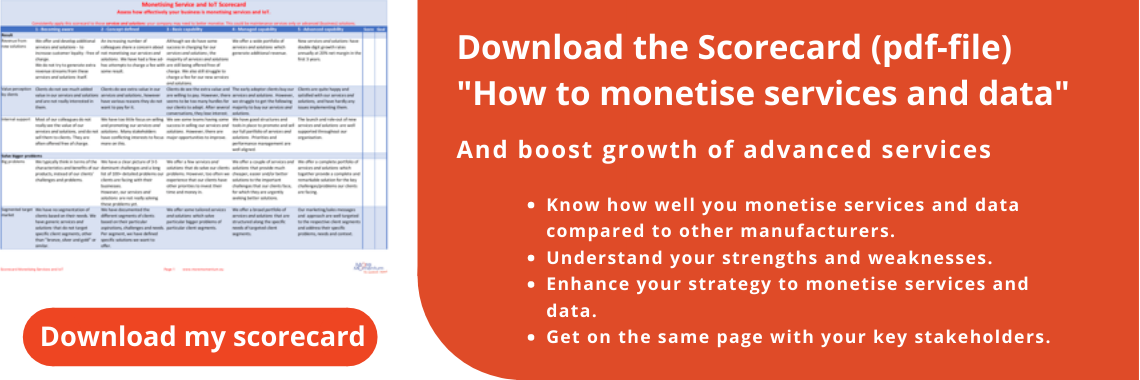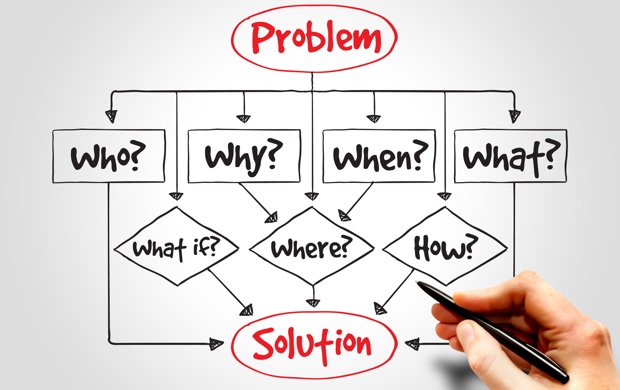Too often we see that (new) services, solutions or features are promoted without connecting the dots to their bigger problems.
Watch video
Central Question: How to Monetise Services
This article is the third of my series of five in which I cover 4 critical steps which make the difference between success and failure in monetising services:
Read my introduction to this topic in Why it is important to monetise services
Common mistakes in articulating your value
Too often we see that (new) services, solutions or features are promoted to clients without connecting the dots to their bigger problems.
For example, a client of mine – a major equipment manufacturer – experienced the power of explicitly connecting the dots. They launched a first version of a portal with many online technical manuals to serve DIY clients which had their own maintenance departments. They initially presented the benefit of this portal as a way to save time when a maintenance engineer of their client needed to find the right manual. It turned out to be tough to sell paid subscriptions for this portal.
Only when the manufacturer articulated their view of the key problems of their clients’ maintenance departments and how the portal would solve these problems, did the clients get really interested. It appeared that the real problem of clients was the daily pressure to increase availability and uptime with shrinking budgets and the slow learning curves of their maintenance engineers, due to low volume of certain problem-solving work. A portal which would evolve into a broad toolset for best practices, trouble-shooting and maintenance management was considered a crucial asset.
Furthermore, we often see manufacturers thinking and talking about features and activities, instead of customer value, while clients only pay for the value they perceive, not for what you do.
A striking example: Field service engineers of another client normally spend a full day in pairs to install equipment which was already delivered a couple of days before. They unpack and assemble the components, connect it to a couple of other devices from different manufacturers and the client’s IT network. This involves solving many integration and security issues with the client’s IT department – which by nature tends to be reluctant. A few days after installation, another colleague visits the client for training and commissioning.
And here is how they brief their client when they start the job: “We are here to unbox the components, put the bits and pieces together and check if everything is on site, so the trainer is ready to go……” . Their client did not even know what kind of complex integration problems the engineers were solving. Actually, their client even wondered why his supplier did not have more mature and efficient processes to get the job done. And by no means are the engineers to blame for this.

Some practical solutions
You can easily start improving on these common mistakes:
- Build a compelling story of your view of your customers challenges, opportunities and problems, which is validated by (a segment of) your customers. Relate this to strategic or crucial priorities of your clients.
Include your view on how your clients could best pursue these opportunities and solve these problems. Just start with a first strawman version and let it grow in time. Do not try to get this perfect the first time.
- Link the characteristics and benefits of your solutions and services to the challenges, opportunities and problems of your clients.
- If possible, quantify the benefits in terms of the strategic or critical priorities.
- Ensure that your value story is well articulated in your messaging to (the specific segments of) your clients and is consistent across all touch points. This may involve some staff training.
Conclusion
Clients only pay for the value they perceive. This requires you to explicitly articulate the value of your solutions and services for your clients in relation to their bigger challenges, opportunities and problems.
Do not expect your clients to figure this out themselves.
The Essence
Great offerings and solutions won’t sell themselves.






